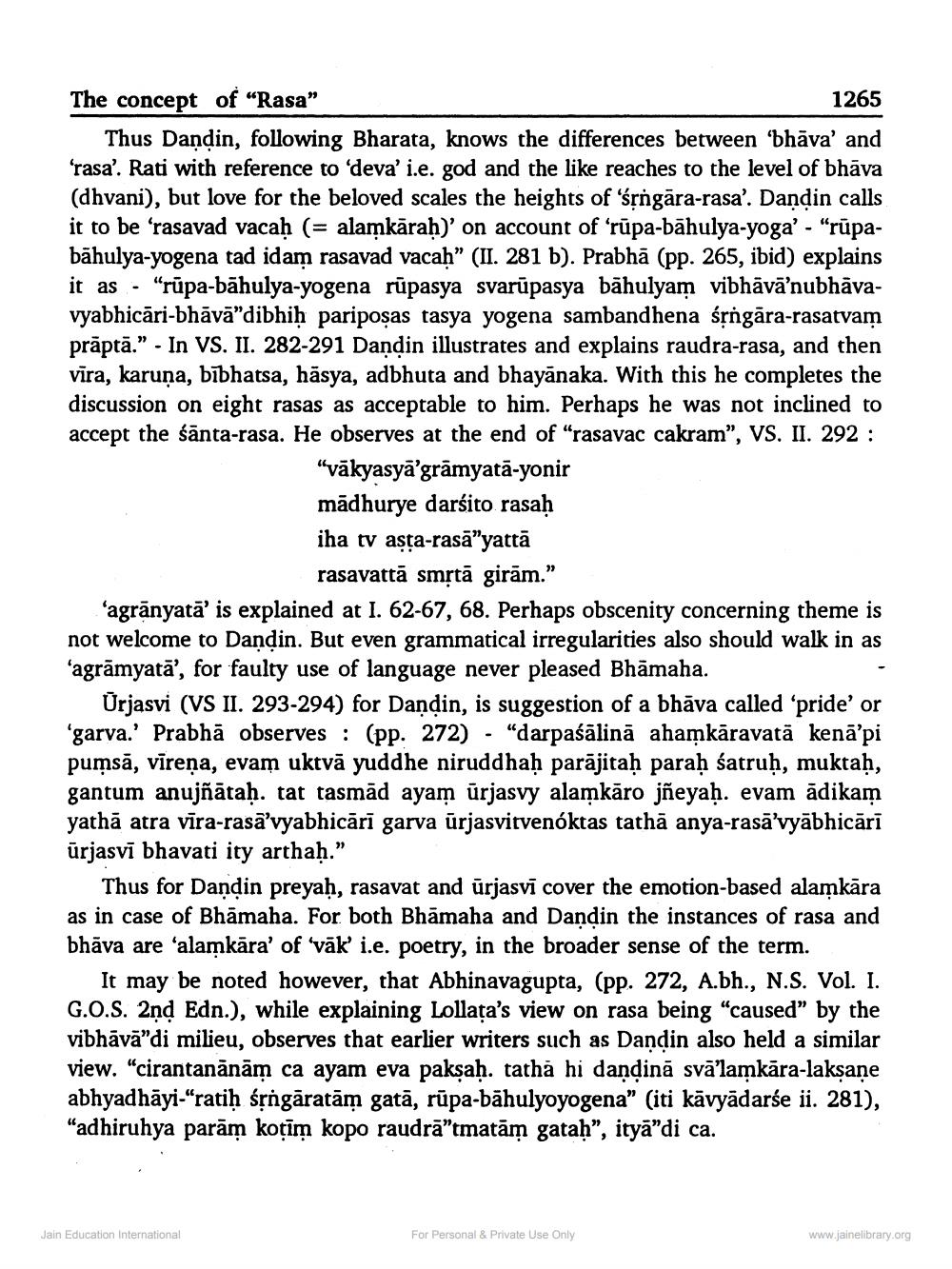________________
The concept of “Rasa”
1265
Thus Dandin, following Bharata, knows the differences between 'bhāva' and 'rasa'. Rati with reference to 'deva' i.e. god and the like reaches to the level of bhāva (dhvani), but love for the beloved scales the heights of 'śộngāra-rasa'. Dandin calls it to be 'rasavad vacaḥ (= alamkāraḥ)' on account of “rūpa-bāhulya-yoga' - “rūpabāhulya-yogena tad idam rasavad vacaḥ” (II. 281 b). Prabhā (pp. 265, ibid) explains it as - "rūpa-bāhulya-yogena rūpasya svarūpasya bāhulyam vibhāvā’nubhāvavyabhicāri-bhāvā"dibhiḥ pariposas tasya yogena sambandhena śộngāra-rasatvam prāptā." - In VS. II. 282-291 Dandin illustrates and explains raudra-rasa, and then vīra, karuna, bībhatsa, hāsya, adbhuta and bhayānaka. With this he completes the discussion on eight rasas as acceptable to him. Perhaps he was not inclined to accept the śānta-rasa. He observes at the end of “rasavac cakram”, VS. II. 292 :
"vākyasyā’grāmyatā-yonir mādhurye darsito rasaḥ iha tv asta-rasā”yattā
rasavattā smrtā girām." 'agrānyatā' is explained at I. 62-67, 68. Perhaps obscenity concerning theme is not welcome to Dandin. But even grammatical irregularities also should walk in as 'agrāmyatā', for faulty use of language never pleased Bhāmaha.
Ürjasvi (VS II. 293-294) for Dandin, is suggestion of a bhāva called 'pride' or 'garva.' Prabhā observes : (pp. 272) · "darpaśālinā ahamkāravatā kenā'pi pumsā, vīrena, evam uktvā yuddhe niruddhaḥ parājitah paraḥ śatruḥ, muktah, gantum anujñātaḥ. tat tasmād ayam ūrjasvy alamkāro jñeyah. evam ādikam yathā atra vīra-rasa’vyabhicārī garva ūrjasvitvenóktas tathā anya-rasā’vyābhicārī ūrjasvī bhavati ity arthah.”
Thus for Dandin preyaḥ, rasavat and ūrjasvī cover the emotion-based alamkāra as in case of Bhāmaha. For both Bhāmaha and Dandin the instances of rasa and bhāva are 'alamkāra' of 'vāk' i.e. poetry, in the broader sense of the term.
It may be noted however, that Abhinavagupta, (pp. 272, A.bh., N.S. Vol. I. G.O.S. 2nd Edn.), while explaining Lollata's view on rasa being "caused by the vibhāvā"di milieu, observes that earlier writers such as Dandin also held a similar view. "cirantanānām ca ayam eva paksaḥ. tatha hi dandinā svā'lamkāra-laksane abhyadhāyi-“ratiḥ śộngāratām gatā, rūpa-bāhulyoyogena" (iti kävyādarśe ii. 281), "adhiruhya parām kotīm kopo raudrā”tmatām gataḥ”, ityā”di ca.
Jain Education International
For Personal & Private Use Only
www.jainelibrary.org




